Abstract
We report that leukotriene B4 (LTB4), a 5-lipoxygenase metabolite of arachidonic acid, is a potent suppressor of polyclonal Ig production in pokeweed mitogen (PWM)-stimulated cultures of human peripheral blood lymphocytes, while LTC4 and LTD4 have little activity in this system. Preincubation of T cells with LTB4 in nanomolar to picomolar concentrations rendered these cells suppressive of Ig production in subsequent PWM-stimulated cultures of fresh, autologous B + T cells. This LTB4-induced suppressor cell was radiosensitive, and its generation could be blocked by cyclohexamide but not by mitomycin C. The LTB4-induced suppressor cell was OKT8(+), while the precursor for the cell could be OKT8(-). The incubation of OKT8(-) T cells with LTB4 for 18 h resulted in the appearance of the OKT8(+) on 10-20% of the cells, and this could be blocked by cyclohexamide but not by mitomycin C. Thus, LTB4 in very low concentrations induces a radiosensitive OKT8(+) suppressor cell from OKT8(-) cells. In this regard, LTB4 is three to six orders of magnitude more potent than any endogenous hormonal inducer of suppressor cells previously described. Glucocorticosteroids, which block suppressor cell induction in many systems, may act by inhibiting endogenous production of LTB4.
Full text
PDF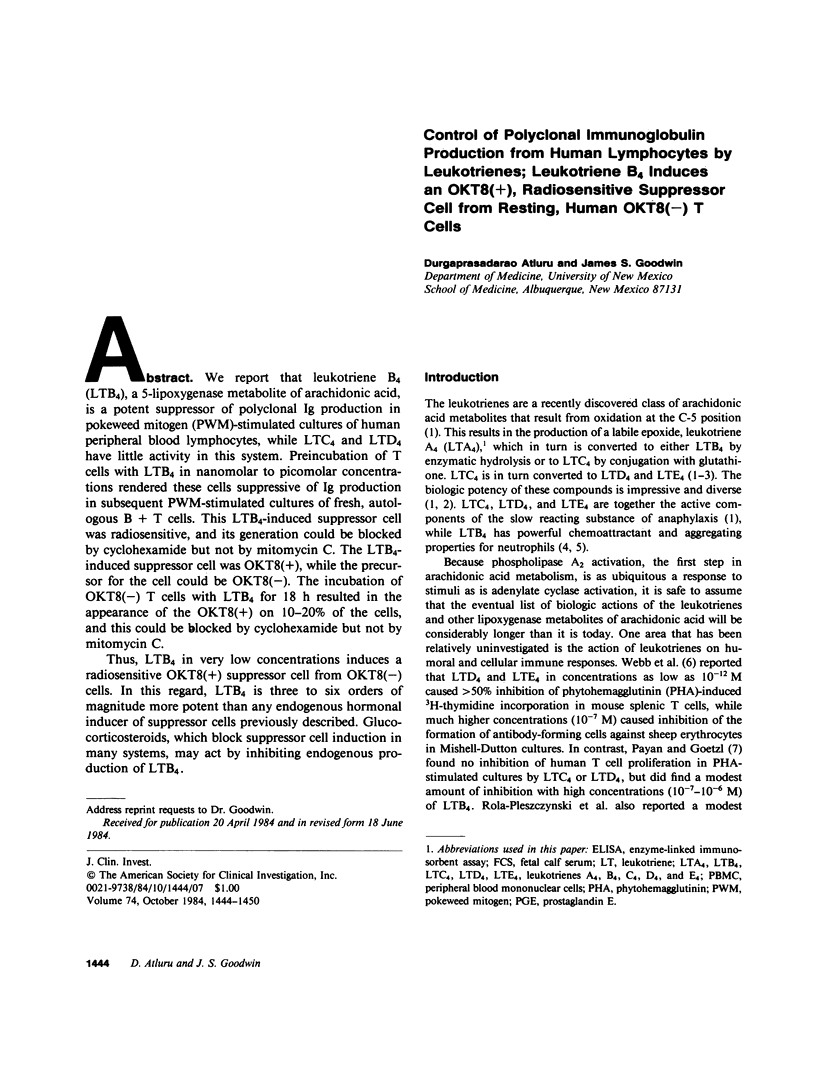
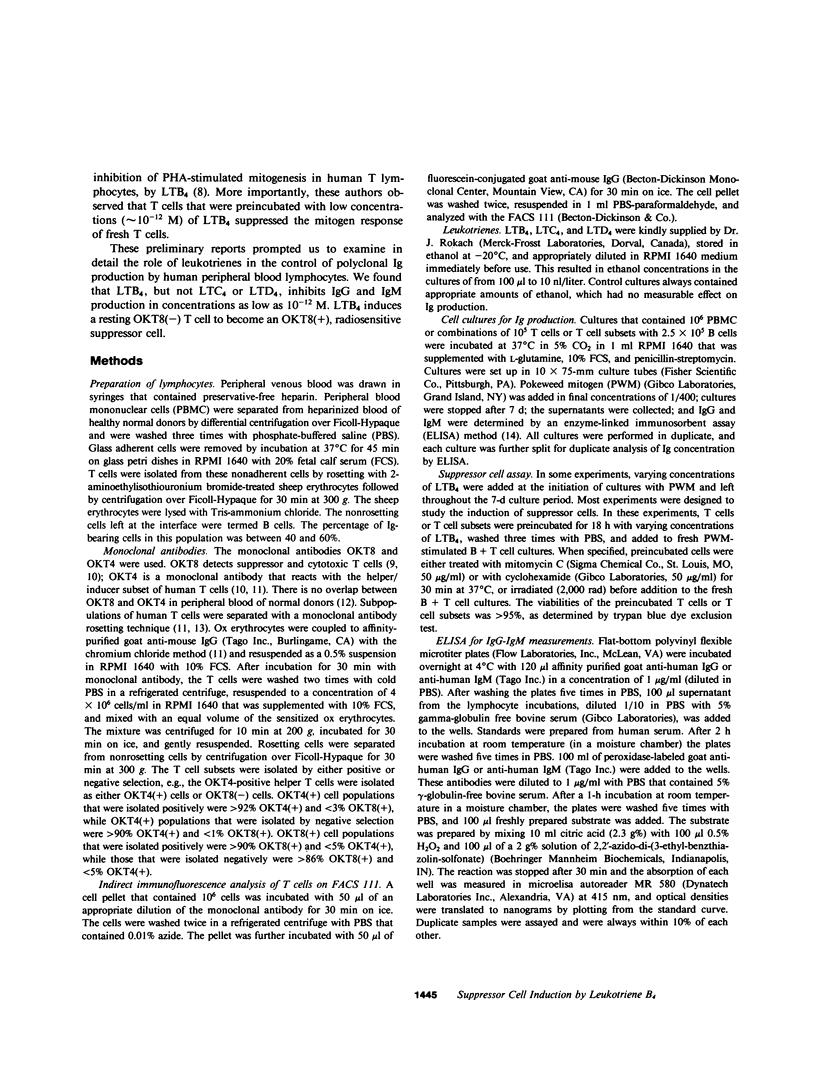
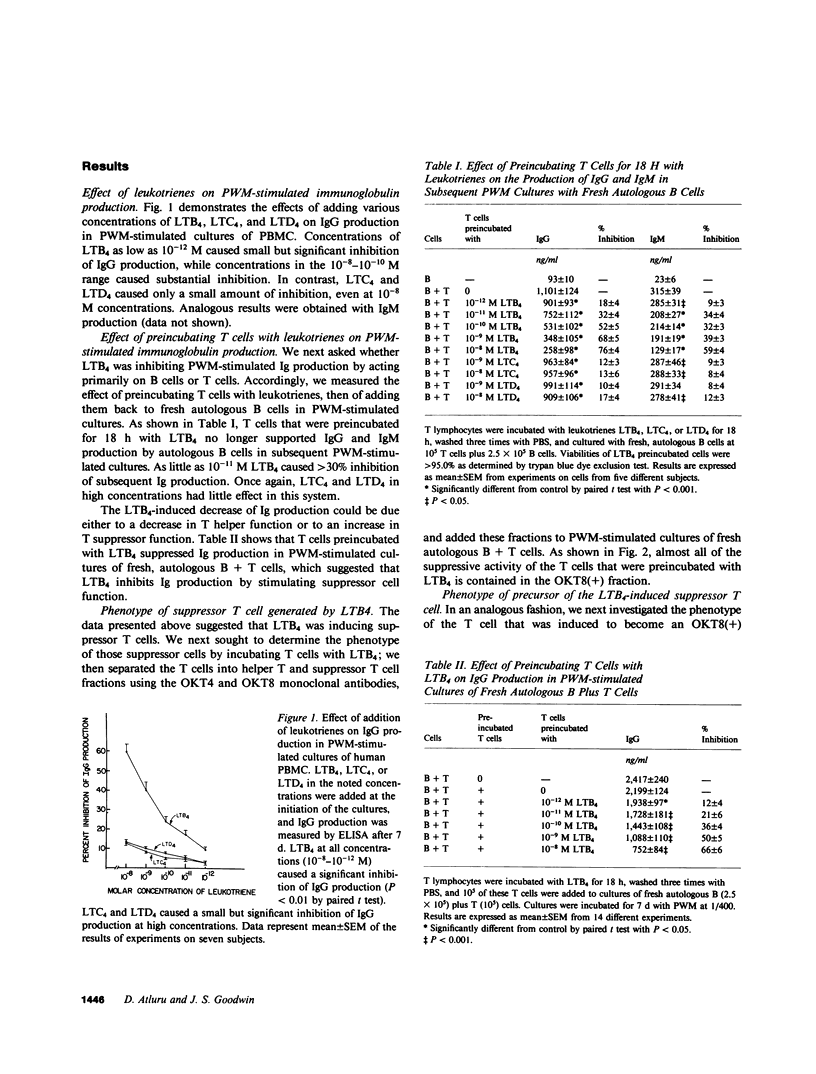
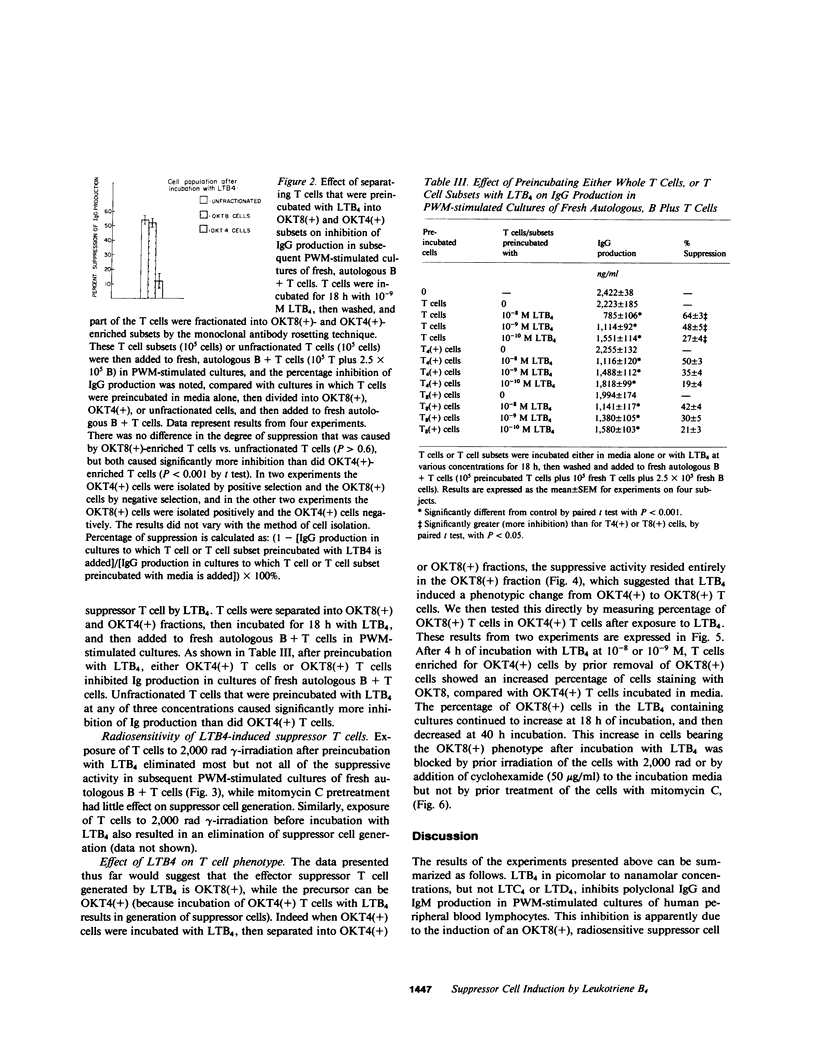
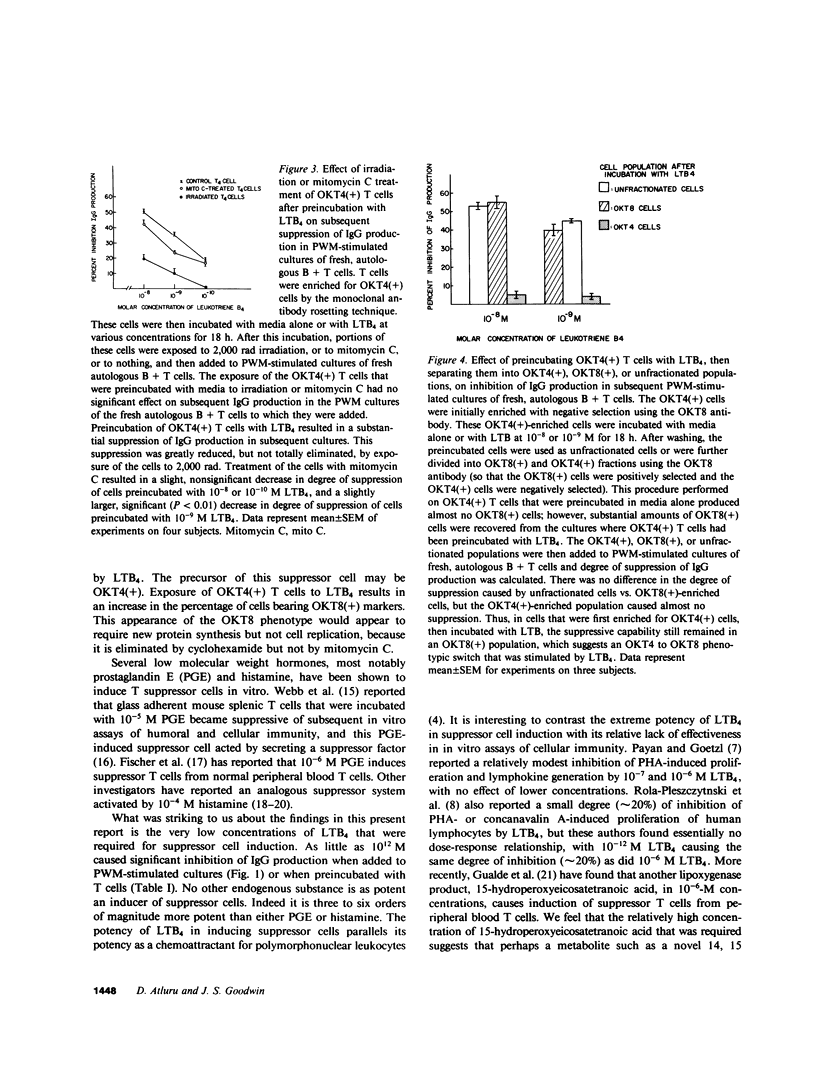
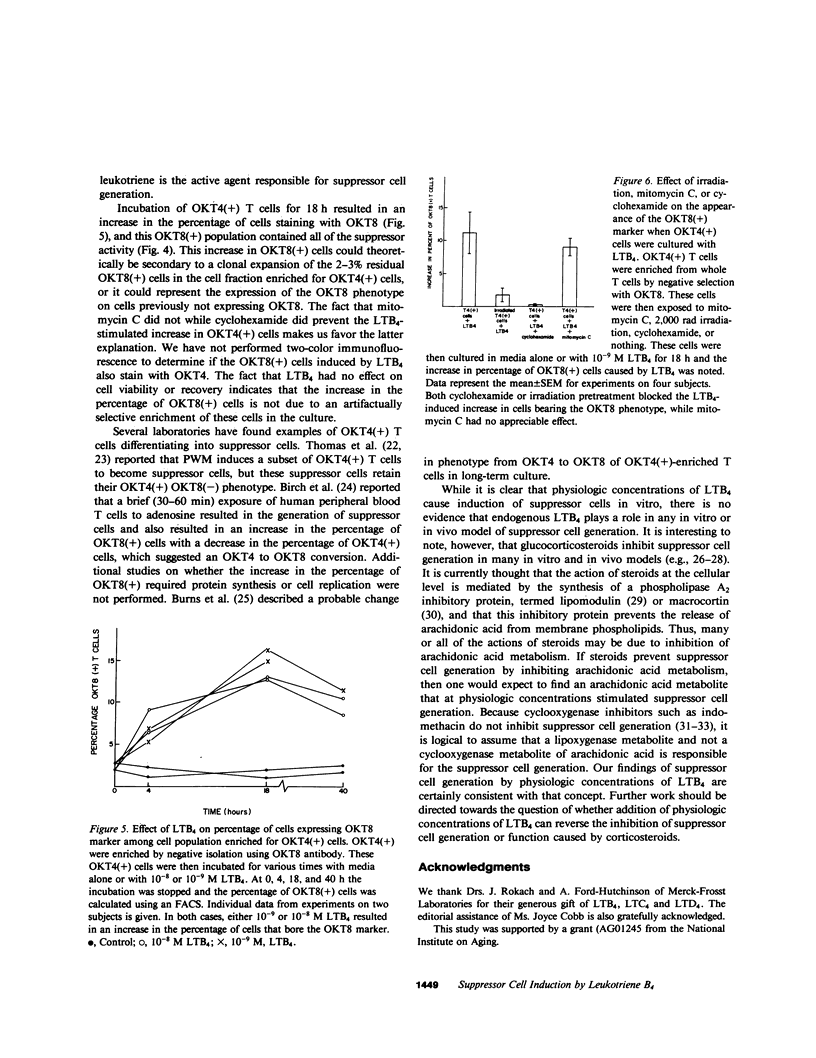

Images in this article
Selected References
These references are in PubMed. This may not be the complete list of references from this article.
- Badger A. M., Griswold D. E., Walz D. T. Augmentation of concanavalin A-induced immunosuppression by indomethacin. Immunopharmacology. 1982 Apr;4(2):149–162. doi: 10.1016/0162-3109(82)90017-0. [DOI] [PubMed] [Google Scholar]
- Birch R. E., Rosenthal A. K., Polmar S. H. Pharmacological modification of immunoregulatory T lymphocytes . II. Modulation of T lymphocyte cell surface characteristics. Clin Exp Immunol. 1982 Apr;48(1):231–238. [PMC free article] [PubMed] [Google Scholar]
- Blackwell G. J., Carnuccio R., Di Rosa M., Flower R. J., Parente L., Persico P. Macrocortin: a polypeptide causing the anti-phospholipase effect of glucocorticoids. Nature. 1980 Sep 11;287(5778):147–149. doi: 10.1038/287147a0. [DOI] [PubMed] [Google Scholar]
- Borgeat P., Samuelsson B. Arachidonic acid metabolism in polymorphonuclear leukocytes: unstable intermediate in formation of dihydroxy acids. Proc Natl Acad Sci U S A. 1979 Jul;76(7):3213–3217. doi: 10.1073/pnas.76.7.3213. [DOI] [PMC free article] [PubMed] [Google Scholar]
- Burns G. F., Battye F. L., Goldstein G. Surface antigen changes occurring in short-term cultures of activated human T lymphocytes: analysis by flow cytometry. Cell Immunol. 1982 Jul 15;71(1):12–26. doi: 10.1016/0008-8749(82)90492-0. [DOI] [PubMed] [Google Scholar]
- Ceuppens J. L., Goodwin J. S. Regulation of immunoglobulin production in pokeweed mitogen-stimulated cultures of lymphocytes from young and old adults. J Immunol. 1982 Jun;128(6):2429–2434. [PubMed] [Google Scholar]
- Ceuppens J. L., Goodwin J. S., Searles R. P. The presence of Ia antigen on human peripheral blood T cells and T-cell subsets: analysis with monoclonal antibodies and the fluorescence-activated cell sorter. Cell Immunol. 1981 Nov 1;64(2):277–292. doi: 10.1016/0008-8749(81)90480-9. [DOI] [PubMed] [Google Scholar]
- Ceuppens J. L., Gualde N., Goodwin J. S. Phenotypic heterogeneity of the OKM 1-positive lymphocyte population: reactivity of OKM1 monoclonal antibody with a subset of the suppressor/cytotoxic T-cell population. Cell Immunol. 1982 May 1;69(1):150–165. doi: 10.1016/0008-8749(82)90059-4. [DOI] [PubMed] [Google Scholar]
- Fischer A., Durandy A., Griscelli C. Role of prostaglandin E2 in the induction of nonspecific T lymphocyte suppressor activity. J Immunol. 1981 Apr;126(4):1452–1455. [PubMed] [Google Scholar]
- Ford-Hutchinson A. W., Bray M. A., Doig M. V., Shipley M. E., Smith M. J. Leukotriene B, a potent chemokinetic and aggregating substance released from polymorphonuclear leukocytes. Nature. 1980 Jul 17;286(5770):264–265. doi: 10.1038/286264a0. [DOI] [PubMed] [Google Scholar]
- Goetzl E. J., Brindley L. L., Goldman D. W. Enhancement of human neutrophil adherence by synthetic leukotriene constituents of the slow-reacting substance of anaphylaxis. Immunology. 1983 Sep;50(1):35–41. [PMC free article] [PubMed] [Google Scholar]
- Goodwin J. S. Modulation of conconavalin-A-induced suppressor cell activation by prostaglandin E2. Cell Immunol. 1980 Feb;49(2):421–425. doi: 10.1016/0008-8749(80)90046-5. [DOI] [PubMed] [Google Scholar]
- Hirata F., Schiffmann E., Venkatasubramanian K., Salomon D., Axelrod J. A phospholipase A2 inhibitory protein in rabbit neutrophils induced by glucocorticoids. Proc Natl Acad Sci U S A. 1980 May;77(5):2533–2536. doi: 10.1073/pnas.77.5.2533. [DOI] [PMC free article] [PubMed] [Google Scholar]
- Lewis R. A., Austen K. F. Mediation of local homeostasis and inflammation by leukotrienes and other mast cell-dependent compounds. Nature. 1981 Sep 10;293(5828):103–108. doi: 10.1038/293103a0. [DOI] [PubMed] [Google Scholar]
- Payan D. G., Goetzl E. J. Specific suppression of human T lymphocyte function by leukotriene B4. J Immunol. 1983 Aug;131(2):551–553. [PubMed] [Google Scholar]
- Reinherz E. L., Kung P. C., Goldstein G., Schlossman S. F. Separation of functional subsets of human T cells by a monoclonal antibody. Proc Natl Acad Sci U S A. 1979 Aug;76(8):4061–4065. doi: 10.1073/pnas.76.8.4061. [DOI] [PMC free article] [PubMed] [Google Scholar]
- Reinherz E. L., Morimoto C., Penta A. C., Schlossman S. F. Regulation of B cell immunoglobulin secretion by functional subsets of T lymphocytes in man. Eur J Immunol. 1980 Jul;10(7):570–572. doi: 10.1002/eji.1830100715. [DOI] [PubMed] [Google Scholar]
- Rocklin R. E., Breard J., Gupta S., Good R. A., Melmon K. L. Characterization of the human blood lymphocytes that produce a histamine-induced suppressor factor (HSF). Cell Immunol. 1980 May;51(2):226–237. doi: 10.1016/0008-8749(80)90255-5. [DOI] [PubMed] [Google Scholar]
- Rocklin R. E., Greineder D., Littman B. H., Melmon K. L. Modulation of cellular immune function in vitro by histamine receptor-bearing lymphocytes: mechanism of action. Cell Immunol. 1978 Apr;37(1):162–173. doi: 10.1016/0008-8749(78)90184-3. [DOI] [PubMed] [Google Scholar]
- Rogers T. J., Nowowiejski I., Webb D. R. Partial characterization of a prostaglandin-induced suppressor factor. Cell Immunol. 1980 Mar 1;50(1):82–93. doi: 10.1016/0008-8749(80)90008-8. [DOI] [PubMed] [Google Scholar]
- Rola-Pleszczynski M., Borgeat P., Sirois P. Leukotriene B4 induces human suppressor lymphocytes. Biochem Biophys Res Commun. 1982 Oct 29;108(4):1531–1537. doi: 10.1016/s0006-291x(82)80081-8. [DOI] [PubMed] [Google Scholar]
- Samuelsson B. Leukotrienes: mediators of immediate hypersensitivity reactions and inflammation. Science. 1983 May 6;220(4597):568–575. doi: 10.1126/science.6301011. [DOI] [PubMed] [Google Scholar]
- Shearer G. M., Melmon K. L., Weinstein Y., Sela M. Regulation of antibody response by cells expressing histamine receptors. J Exp Med. 1972 Nov 1;136(5):1302–1307. doi: 10.1084/jem.136.5.1302. [DOI] [PMC free article] [PubMed] [Google Scholar]
- Soppi E., Eskola J., Ruuskanen O. Effects of indomethacin on lymphocyte proliferation, suppressor cell function, and leukocyte migration inhibitory factor (lmif) production. Immunopharmacology. 1982 Jun;4(3):235–242. doi: 10.1016/0162-3109(82)90005-4. [DOI] [PubMed] [Google Scholar]
- Stocker J. W., Garotta G., Hausmann B., Trucco M., Ceppellini R. Separation of human cells bearing HLA-DR antigens using a monoclonal antibody rosetting method. Tissue Antigens. 1979 Mar;13(3):212–222. doi: 10.1111/j.1399-0039.1979.tb00786.x. [DOI] [PubMed] [Google Scholar]
- Thomas Y., Rogozinski L., Irigoyen O. H., Friedman S. M., Kung P. C., Goldstein G., Chess L. Functional analysis of human T cell subsets defined by monoclonal antibodies. IV. Induction of suppressor cells within the OKT4+ population. J Exp Med. 1981 Aug 1;154(2):459–467. doi: 10.1084/jem.154.2.459. [DOI] [PMC free article] [PubMed] [Google Scholar]
- Thomas Y., Rogozinski L., Irigoyen O. H., Shen H. H., Talle M. A., Goldstein G., Chess L. Functional analysis of human T cell subsets defined by monoclonal antibodies. V. Suppressor cells within the activated OKT4+ population belong to a distinct subset. J Immunol. 1982 Mar;128(3):1386–1390. [PubMed] [Google Scholar]
- Tosato G., Magrath I. T., Koski I. R., Dooley N. J., Blaese R. M. B cell differentiation and immunoregulatory T cell function in human cord blood lymphocytes. J Clin Invest. 1980 Aug;66(2):383–388. doi: 10.1172/JCI109867. [DOI] [PMC free article] [PubMed] [Google Scholar]
- Tosato G., Magrath I., Koski I., Dooley N., Blaese M. Activation of suppressor T cells during Epstein-Barr-virus-induced infectious mononucleosis. N Engl J Med. 1979 Nov 22;301(21):1133–1137. doi: 10.1056/NEJM197911223012101. [DOI] [PubMed] [Google Scholar]
- Waldmann T. A., Broder S., Krakauer R., MacDermott R. P., Durm M., Goldman C., Meade B. The role of suppressor cells in the pathogenesis of common variable hypogammaglobulinemia and the immunodeficiency associated with myeloma. Fed Proc. 1976 Jul;35(9):2067–2072. [PubMed] [Google Scholar]
- Webb D. R., Nowowiejski I., Healy C., Rogers T. J. Immunosuppressive properties of leukotriene D4 and E4 in vitro. Biochem Biophys Res Commun. 1982 Feb 26;104(4):1617–1622. doi: 10.1016/0006-291x(82)91438-3. [DOI] [PubMed] [Google Scholar]
- Webb D. R., Nowowiejski I. The role of prostaglandins in the control of the primary 19S immune response to sRBC. Cell Immunol. 1977 Sep;33(1):1–10. doi: 10.1016/0008-8749(77)90129-0. [DOI] [PubMed] [Google Scholar]



